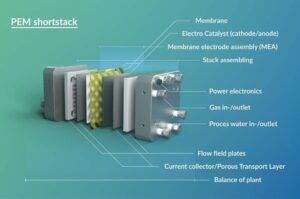While OneH2 has been operating fleets of 520-bar hydrogen transport trailers for materials-handling applications, the new 931-bar design enables direct fills of higher-pressure, 700-bar automotive and heavy-vehicle applications, making hydrogen-fueled transport much more economical.
By transporting hydrogen gas at higher pressures, OneH2 bypasses the extra processing normally required by delivery methods such as lower-pressure gaseous transport, which requires further compression at the point of use; and in the case of liquid hydrogen, post-delivery processing often includes several stages of vaporization and compression before the hydrogen is usable as a transport fuel. All these processes add cost, time, and can impact reliability. When factored into the price of the fuel, this can be significant, especially at scale.
Nishanth Gorukanti, General Manager Operations & Maintenance for OneH2, commented: “OneH2 is very excited to launch the 931 bar high-pressure tube trailers in the market. This system design will help to store larger quantities of gaseous hydrogen for transportation, thereby avoiding any use of onboard compression on the trailer or compression systems at the retail point of use.”
931-bar trailers consist of various combinations of high-pressure cylinders packaged together. Each cylinder can hold up to 27 kg (gross) of gaseous hydrogen at 931-bar pressure, which is close to three times that of the cylinder technology OneH2 previously used.
Trailers can be configured in various capacities. With a maximum configuration of 18 cylinders, a single trailer can hold up to 486 kg of fuel-cell grade hydrogen. If on-site space is an issue, OneH2 offers smaller trailer configurations (down to 6 cylinders, 160 kg) promoting better maneuverability in tighter environments.
To ensure maximum utilization of onboard hydrogen, OneH2 uses a patented cascading function, allowing each cylinder to act as its own cascading bank. Cascading is a method of intelligently drawing from different cylinders, to refuel the vehicles in such a way that the remaining inaccessible hydrogen gas in storage cylinders is kept to a minimum.
The trailer also includes key features that optimize performance and safety, such as onboard hydrogen gas sensors, on-tank actuator valves for isolation, telemetry to report the status of the trailer on-road, safety interlocks, and a temperature and pressure relief device (TPRD) for each tank.
The trailer’s cylinders are designed and tested in accordance with international standards that provide specifications for the design, construction, and testing of type IV composite cylinders.
OneH2 also offers 931-bar mobile fuelers using the same cylinder technology. The refueler includes an onboarded dispensing system for both 350-bar and 700-bar pressure, turning the trailer into a portable fueling station.
This mobile and portable refueling station allows customers to receive hydrogen at any location and immediately refuel vehicles, with minimal to no investment in on-site equipment and reducing permitting and construction headaches.






